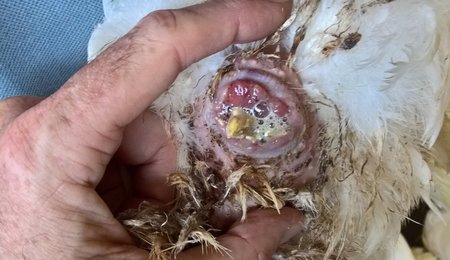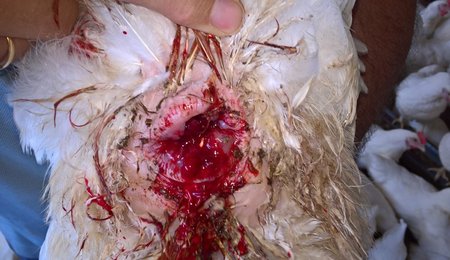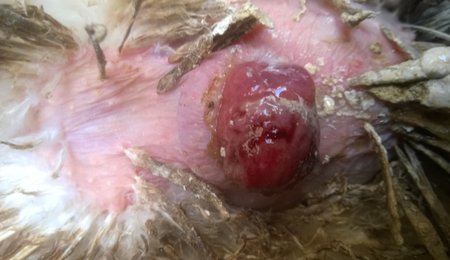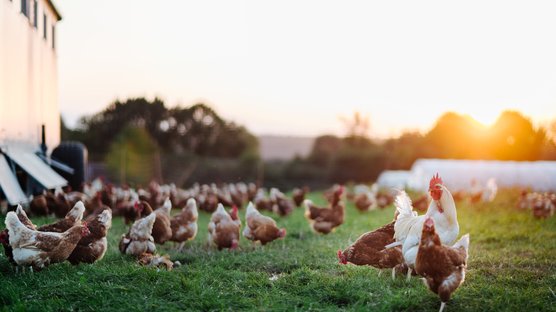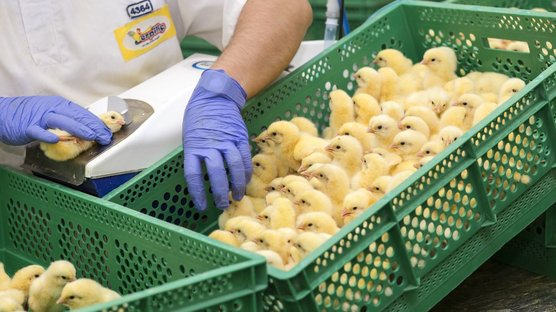
Published on Nov. 7, 2022
Prolapse in Laying hens
Despite the permanent improvement of layer production results that can be evidenced in different housing conditions and in all regions of the world, thanks to genetic selection and advances in nutrition, management, and disease prevention, prolapse continues to be a recurring cause of concern for poultry producers.
The appearance of prolapse in laying hens, under certain circumstances, can become one of the main causes of mortality, with the consequent negative impact on the welfare of the chickens and on the productive results of the flocks.
In this article we will review the conditions that contribute fundamentally to the occurrence of prolapse, with emphasis on the different prevention strategies. Indeed, and as we are going to describe, the main causes are related to management problems during rearing and the onset of laying, which means that there is no effective treatment and, therefore, it is a very difficult condition to control once it has appeared. In this case, more than ever, we can affirm that the best method of control is prevention.
What is prolapse?
Under normal conditions, at the time of oviposition, there is a momentary eversion of the lower part of the oviduct through the cloaca, which quickly reverses. Prolapse in laying hens occurs when part of the oviduct does not retract to its normal position and is exposed, outside the cloaca, after the hen lays an egg.
In these circumstances, the exposed tissue presents a congestive appearance and may eventually become necrotic, resulting in mortality. The most frequent complication is that other hens will be attracted to the pink, moist tissue and may start pecking at it, which can lead to an outbreak of cannibalism, resulting in a significant increase in mortality.
Both conditions, prolapse and pecking/cannibalism, are frequently associated, because not only can pecking be the consequence of the original prolapse, as described above, but, conversely, cloacal pecking can be the primary cause, and the small lesions produced in the oviduct tissue at the time of oviposition end up making it difficult for it to retract to its normal position, with prolapse appearing secondarily.
Conditions that favor the appearance of prolapse
Prolapse is considered a multifactorial syndrome, meaning that there is often no single cause, but rather a combination of several factors responsible for the onset of the problem.
The fundamental factors are related to the development of the birds during the rearing phase, essentially weight, composition and body structure (skeletal development). Additionally, hormonal alterations, enteritis, overweight birds, age at the beginning of lay, too early light stimulation, unbalanced diets, production of double yolked eggs and all those conditions that favor the appearance of pecking behavior also play a determining role in the presentation of prolapse.
Weight and body structure of laying hens
Live weight and body development and structure are highly related to the appearance of prolapse. On the one hand, underweight hens, i.e., birds that have not had an adequate growth during the first weeks of rearing, which is when the skeletal structure of the birds is determined, will have a poorly developed pelvic cavity, as well as insufficiently developed reproductive tissues and musculature for laying. On the other hand, overweight hens, with excess accumulated fat, will also be more prone to prolapse, since the tissues involved in oviposition (oviduct and cloacal musculature) will have less elasticity and tone, so that the oviduct will take longer to retract after laying an egg.
On the other hand, laying hens that are too heavy will generally lay larger eggs, an additional risk factor additional risk factor: the larger the egg size the greater the likelihood of excessive cloacal the larger the egg size, the greater the likelihood of excessive cloacal tissue distention and the risk of developing prolapse.
Good housing and management conditions during the first weeks of rearing, ensuring the recommended space allowance for good growth, as well as sufficient availability of feeders and drinkers to avoid competition that may negatively affect growth and uniformity, are essential in the prevention of prolapse.
The other conditions that ensure a good start of the pullets in rearing, such as the use of a slowly decreasing lighting program, a sufficiently concentrated starter feed and the maintenance of a comfortable environment (temperature, relative humidity, and ventilation), are also fundamental to obtain the adequate development.
The objective is to always follow the reference growth curve for the strain, always bearing in mind that the development of the different body structures (skeleton, musculature, gastrointestinal tract...) follows a specific sequence in time, and it is not possible to compensate later a deficit in the growth of any of them.
Hormonal alterations in laying hens
Alterations in the hormonal status of laying hens can lead to prolapse. Low plasma estradiol levels have been found to be associated with the occurrence of prolapse in laying hens. Reduced plasma estradiol levels decrease prostaglandin synthetase activity, resulting in a decreased level of prostaglandin in the oviduct.
Prostaglandin plays an important role in the muscular activity of the oviduct. Prostaglandin levels that are too low negatively affect to the functioning of the smooth musculature of the oviduct, favoring the appearance of prolapse. It should not be forgotten that hormonal regulation in laying hens is greatly affected by photo stimulation (light stimulation): as discussed in the previous section, the effect of the rearing period is essential, so the management and the feeding and lighting program used in rearing must be considered when investigating a flock with a significant prevalence of prolapse.
Chicken behavior
Cloacal pecking, and the cannibalism resulting from this behavior, can be considered both a cause and a consequence of prolapse in laying hens.
Cloacal pecking is one of the most widespread and severe forms of severe pecking: when this behavioral disturbance occurs, cannibalism can spread rapidly and cause high mortality. Hens are attracted by the appearance of the exposed oviduct outside the cloaca after oviposition, moist and shiny: if one of the birds in the flock starts pecking it, the others will do the same because of their curiosity and tendency to imitate.
Injuries resulting from repeated pecking and the presence of blood will further stimulate this severe pecking, exacerbating the problem. Even hens that have undergone beak treatment or trimming can severely injure other members of the flock, as the exposed oviduct is a soft tissue that bleeds easily. However, in regions where beak treatment is authorized by current legislation, the risk of severe pecking is significantly reduced as long as this treatment is carried out accurately and with a uniform result.
When hens are housed in cage-free systems, either on the floor or in aviaries, there will be a higher risk of pecking in those flocks that produce a significant number of eggs outside the nests, in on the ground or in the system. Also, when there is an insufficient number of nests, when nests are too brightly lit or of inadequate design, as the cloaca is exposed when the egg is laid on the floor, it is more likely that another member of the flock will be attracted to nibble on it. Although prolapse can occur in all housing systems, cannibalism often occurs with greater frequency and intensity in birds housed in cages, as there is more interaction between the hens housed in the cage and less opportunity for the victims to escape the aggression.
Age of the hens
Often the highest incidence of prolapse occurs around peak production, a time of high metabolic demand for the birds. As hens age, eggs naturally increase in size, but making this egg weight growth more flattened, as has been achieved through genetics in some strains, will allow the metabolic demand on birds in older flocks to be lower, reducing the risk of developing prolapse.
Double yolk eggs
As a result of the excessive size of double-yolk eggs, a lot of pressure is placed on the uterus and cloacal musculature at the time of oviposition. When these tissues are overstretched, they weaken and the possibility of developing prolapse increases, as it becomes more difficult for the hen to retract the uterus.
Proper management of the light stimulus, at the right age and avoiding overly aggressive stimuli, either in amplitude or intensity, is the most important factor in avoiding excessive double-yolk eggs. On the other hand, genetic improvement can also help to reduce the incidence of prolapse by actively selecting against the appearance of double-yolk eggs.
Unbalanced poultry diets
The main nutritional factors to consider in formulas to help prevent the onset of prolapse are energy, protein, calcium, and phosphorus levels. Specifically, the use of a pre-lay feed properly formulated for the specific needs of this brief but essential period, as this is the time when calcium stores are established in the medullary bone, will help to reduce the risk of prolapse later in life.
It should be kept in mind that calcium plays an important role, not only for the formation of the eggshell and strong, healthy bones, but also for the proper functioning of the muscles and the maintenance of muscle tone. Muscle weakness can hinder and delay retraction of the oviduct after egg laying, and consequently prolapse can occur. Ensuring adequate calcium and phosphorus intake at each stage of productive life according to the egg mass produced to guarantee the proper functioning of calcium absorption/deposition/excretion mechanisms is another key factor in reducing the risk of prolapse.
Excess fat in the abdominal region also favors the appearance of prolapse: the presence of too much fat can narrow the passage of the egg, increasing the pressure that the hen needs to lay it and stretching and weakening the muscles involved. Therefore, a balanced diet that allows the maintenance of body weight in the recommended range and does not favor the accumulation of abdominal fat is key. It is important to avoid formulas with a too high metabolizable energy content, either by excessive intake of carbohydrates, oils, or fats.
The use of very high levels of protein will also potentially result in the following an increased risk of prolapse by encouraging the production of larger eggs. However, nutritionally stimulating the production of heavier eggs in markets that demand them should not be too much of a concern as long as it is done gradually.
Finally, the role of fiber should not be underestimated in relation to the behavior of laying hens: fiber can have a very positive impact on intestinal health, which in turn results in better behavior of laying hens, which will show less tendency to pecking.
Lighting in chicken barns
Excessive light intensity conditions will stimulate the birds' activity and make it easier for them to see the exposed oviduct after egg laying and attract their attention, as they are naturally curious.
The light stimulus (photo stimulation by adding extra hours of light) should always be based on body weight and uniformity, never based exclusively on the age of the birds. Although it is well known, it is always advisable to emphasize the importance of monitor body weight weekly during the rearing period and ensure that growth follows the recommended growth objectives for the breed.
An important effect of light is the alteration of the age of onset of sexual maturity of the birds, and of the appearance of the first eggs. It is important to keep in mind that it is not the intensity of light that will fundamentally affect the age of sexual maturity, but the change in the length of the day perceived by the birds (hours of light). Again, to reiterate that the evolution of body weight during rearing provides much information on their level of development and body composition.
Chicks that receive a light stimulus before the reproductive tract is fully mature will be candidates for prolapse problems later in the laying phase.
Flocks of excessively early birds will produce small eggs, but are undoubtedly more prone to prolapse problems, as the birds will have a small body structure and an underdeveloped reproductive tract. It is essential to take into account flock uniformity: when the variability in weights is excessive, it will be very difficult for the poultry producer to make the right decision regarding the timing of photo stimulation: if only the average body weight is taken into account, for the lighter birds it may be too early, and this will result in prolapse mortality in production.
At the time of light stimulation, it is not advisable to be too aggressive, avoiding too large increases in duration or a sudden increase in intensity, as this will lead to a higher incidence of double-yolk eggs.
It is always important to respect the recommendations of the different strains regarding lighting programs, light stimulation and light intensity in each phase.
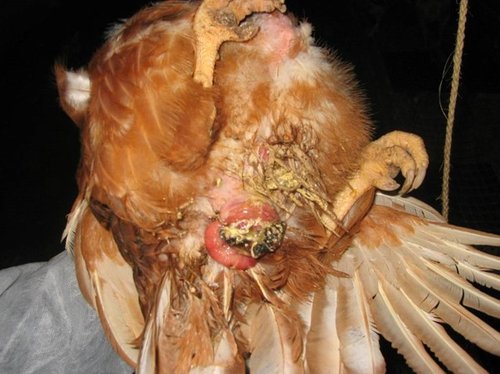
Health status of the flock
Some diseases can also act as risk factors for prolapse. Enteritis can cause diarrhea, cloacal irritation, and dirty feathers around the cloaca, which will also favor pecking behavior. On the other hand, inadequate intestinal health can negatively affect nutrient absorption and marginal deficiencies can occur in affected individuals.
Other viral processes such as egg drop syndrome (EDS) and infectious bronchitis cause weakening of the oviduct. Endoparasites (worms and tapeworms) will alter the intestinal mucosa, nutrient absorption will be affected, and they are also a permanent source of stress, all of which are possible triggers for pecking. Something similar could be said about ectoparasites: lice and mites cause skin irritation and stress, and their presence is often associated with behavioral disturbances and itching.
Recommendations to prevent the onset of prolapse in laying hens
Most of the strategies for prolapse prevention can easily be deduced from the description of the factors involved described above, but some tips are briefly outlined below:
- Early detection is essential: an early indicator of the onset of prolapse is the presence of eggs with blood-stained shells: remain vigilant and watch closely when collecting and sorting eggs.
- Visit plots frequently, pay attention to sounds that may indicate severe pecking behavior (squawking of aggrieved birds), look for signs of pecking. and try to isolate the injured birds.
- Supervise the use of the nests, verifying that they are in sufficient number for the number of hens housed, that they are comfortable and attractive to the birds. Control the opening and closing times of the nests to minimize the laying of eggs on the floor and to avoid that the birds remain too long in the nests, both situations can favor the pecking of cloaca.
- Verify that the space available for feeders and drinkers is adequate for the number of hens housed. Competition around feeders or drinkers will affect flock uniformity and may lead to abnormal behavior and pecking.
- Closely monitor body weight, growth, and development of birds during rearing. Avoid underweight or overweight birds, adjust management and feeding when necessary.
- Keep in mind that the timing of the light stimulus should be determined by body weight and uniformity of the flock.
- Avoid too abrupt photo stimulation.
- Maintain the light intensity inside the house whenever possible according to the breed recommendations. Ideally use artificial lights that can be adjusted in intensity and in the case of open houses, try to reduce the intensity of natural light entering the house by darkening windows or using curtains or shading screens.
- Always use well-balanced diets, introducing the necessary changes gradually and according to flock needs: according to body weight in rearing and egg mass produced in production.
various footage of prolapse in laying hens
